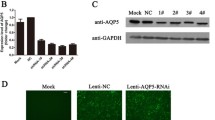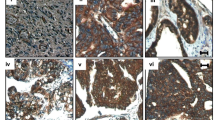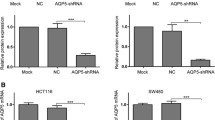Abstract
Objective
Aquaporin (AQP) water channels are expressed in high-grade tumor cells of different tissue origins. Based on the involvement of AQPs in angiogenesis and cell migration as well as our previous studies which show that AQP3 is involved in human skin fibroblasts cell migration, in this study, we investigated whether AQP3 is expressed in cultured human ovarian cancer cell line CaOV3 cells, and whether AQP3 expression in these cells enhances cell migration and metastatic potential.
Methods
Cultured CaOV3 cells were treated with EGF and/or various reagents and subjected to cell migration assay by phagokinetic track mobility assay or biochemical analysis for expression or activation of proteins by SDS-PAGE/Western blot analysis.
Results
In this study, we demonstrate that AQP3 is expressed in CaOV3 cells. EGF induces CaOV3 migration and up-regulates AQP3 expression. EGF-induced cell migration is inhibited by specific AQP3 siRNA knockdown or AQP3 water transport inhibitor CuSO4 and NiCl2. We also find that curcumin, a well known anti-ovarian cancer drug, down-regulates AQP3 expression and reduces cell migration in CaOV3, and the effects of curcumin are mediated, at least in part, by its inhibitory effects on EGFR and downstream AKT/ERK activation.
Conclusions
Collectively, our results provide evidence for AQP3-facilitated ovarian cancer cell migration, suggesting a novel function for AQP3 expression in high-grade tumors. The results that curcumin inhibits EGF-induced up-regulation of AQP3 and cell migration, provide a new explanation for the anticancer potential of curcumin.





Similar content being viewed by others
References
Albanell J, Gascon P (2005) Small molecules with EGFR-TK inhibitor activity. Curr Drug Targets 6:259–274
Bache KG, Slagsvold T, Stenmark H (2004) Defective downregulation of receptor tyrosine kinases in cancer. Embo J 23:2707–2712
Cao C, Healey S, Amaral A, Lee-Couture A, Wan S, Kouttab N, Chu W, Wan Y (2007) ATP-sensitive potassium channel: a novel target for protection against UV-induced human skin cell damage. J Cell Physiol 212:252–263
Cao C, Sun Y, Healey S, Bi Z, Hu G, Wan S, Kouttab N, Chu W, Wan Y (2006) EGFR-mediated expression of aquaporin-3 is involved in human skin fibroblast migration. Biochem J 400:225–234
Chen A, Xu J, Johnson AC (2006) Curcumin inhibits human colon cancer cell growth by suppressing gene expression of epidermal growth factor receptor through reducing the activity of the transcription factor Egr-1. Oncogene 25:278–287
Dancey JE, Freidlin B (2003) Targeting epidermal growth factor receptor—are we missing the mark? Lancet 362:62–64
Ellerbroek SM, Hudson LG, Stack MS (1998) Proteinase requirements of epidermal growth factor-induced ovarian cancer cell invasion. Int J Cancer 78:331–337
Henic E, Sixt M, Hansson S, Hoyer-Hansen G, Casslen B (2006) EGF-stimulated migration in ovarian cancer cells is associated with decreased internalization, increased surface expression, and increased shedding of the urokinase plasminogen activator receptor. Gynecol Oncol 101:28–39
Hu J, Verkman AS (2006) Increased migration and metastatic potential of tumor cells expressing aquaporin water channels. Faseb J 20:1892–1894
Jiang Q, Zhou C, Healey S, Chu W, Kouttab N, Bi Z, Wan Y (2006) UV radiation down-regulates Dsg-2 via Rac/NADPH oxidase-mediated generation of ROS in human lens epithelial cells. Int J Mol Med 18:381–387
Khor TO, Keum YS, Lin W, Kim JH, Hu R, Shen G, Xu C, Gopalakrishnan A, Reddy B, Zheng X et al (2006) Combined inhibitory effects of curcumin and phenethyl isothiocyanate on the growth of human PC-3 prostate xenografts in immunodeficient mice. Cancer Res 66:613–621
Kim JH, Xu C, Keum YS, Reddy B, Conney A, Kong AN (2006) Inhibition of EGFR signaling in human prostate cancer PC-3 cells by combination treatment with beta-phenylethyl isothiocyanate and curcumin. Carcinogenesis 27:475–482
Kim MS, Kim YK, Eun HC, Cho KH, Chung JH (2006) All-trans retinoic acid antagonizes UV-induced VEGF production and angiogenesis via the inhibition of ERK activation in human skin keratinocytes. J Invest Dermatol 126:2697–2706
Kunnumakkara AB, Guha S, Krishnan S, Diagaradjane P, Gelovani J, Aggarwal BB (2007) Curcumin potentiates antitumor activity of gemcitabine in an orthotopic model of pancreatic cancer through suppression of proliferation, angiogenesis, and inhibition of nuclear factor-kappaB-regulated gene products. Cancer Res 67:3853–3861
Lev-Ari S, Starr A, Vexler A, Karaush V, Loew V, Greif J, Fenig E, Aderka D, Ben-Yosef R (2006) Inhibition of pancreatic and lung adenocarcinoma cell survival by curcumin is associated with increased apoptosis, down-regulation of COX-2 and EGFR and inhibition of Erk1/2 activity. Anticancer Res 26:4423–4430
Li M, Zhang Z, Hill DL, Wang H, Zhang R (2007) Curcumin, a dietary component, has anticancer, chemosensitization, and radiosensitization effects by down-regulating the MDM2 oncogene through the PI3K/mTOR/ETS2 pathway. Cancer Res 67:1988–1996
Liu LZ, Hu XW, Xia C, He J, Zhou Q, Shi X, Fang J, Jiang BH (2006) Reactive oxygen species regulate epidermal growth factor-induced vascular endothelial growth factor and hypoxia-inducible factor-1alpha expression through activation of AKT and P70S6K1 in human ovarian cancer cells. Free Radic Biol Med 41:1521–1533
Moon C, Soria JC, Jang SJ, Lee J, Obaidul Hoque M, Sibony M, Trink B, Chang YS, Sidransky D, Mao L (2003) Involvement of aquaporins in colorectal carcinogenesis. Oncogene 22:6699–6703
Ning Y, Buranda T, Hudson LG (2007) Activated EGF receptor induces integrin alpha 2 internalization via caveolae/raft-dependent endocytic pathway. J Biol Chem 282:6380–6387
Qiu L, Di W, Jiang Q, Scheffler E, Derby S, Yang J, Kouttab N, Wanebo H, Yan B, Wan Y (2005) Targeted inhibition of transient activation of the EGFR-mediated cell survival pathway enhances paclitaxel-induced ovarian cancer cell death. Int J Oncol 27:1441–1448
Qiu L, Wang Q, Di W, Jiang Q, Schefeller E, Derby S, Wanebo H, Yan B, Wan Y (2005) Transient activation of EGFR/AKT cell survival pathway and expression of survivin contribute to reduced sensitivity of human melanoma cells to betulinic acid. Int J Oncol 27:823–830
Qiu L, Zhou C, Sun Y, Di W, Scheffler E, Healey S, Kouttab N, Chu W, Wan Y (2006) Crosstalk between EGFR and TrkB enhances ovarian cancer cell migration and proliferation. Int J Oncol 29:1003–1011
Qiu Q, Yang M, Tsang BK, Gruslin A (2004) Both mitogen-activated protein kinase and phosphatidylinositol 3-kinase signalling are required in epidermal growth factor-induced human trophoblast migration. Mol Hum Reprod 10:677–684
Rao CV, Rivenson A, Simi B, Reddy BS (1995) Chemoprevention of colon carcinogenesis by dietary curcumin, a naturally occurring plant phenolic compound. Cancer Res 55:259–266
Shah BH, Neithardt A, Chu DB, Shah FB, Catt KJ (2006) Role of EGF receptor transactivation in phosphoinositide 3-kinase-dependent activation of MAP kinase by GPCRs. J Cell Physiol 206:47–57
Shi M, Cai Q, Yao L, Mao Y, Ming Y, Ouyang G (2006) Antiproliferation and apoptosis induced by curcumin in human ovarian cancer cells. Cell Biol Int 30:221–226
Shien T, Doihara H, Hara H, Takahashi H, Yoshitomi S, Taira N, Ishibe Y, Teramoto J, Aoe M, Shimizu N (2004) PLC and PI3K pathways are important in the inhibition of EGF-induced cell migration by gefitinib (‘Iressa’, ZD1839). Breast Cancer 11:367–373
Takata K, Tajika Y, Matsuzaki T, Aoki T, Suzuki T, Abduxukur A, Hagiwara H (2004) Molecular mechanisms and drug development in aquaporin water channel diseases: water channel aquaporin-2 of kidney collecting duct cells. J Pharmacol Sci 96:255–259
Ullrich A, Schlessinger J (1990) Signal transduction by receptors with tyrosine kinase activity. Cell 61:203–212
Verkman AS (2005) More than just water channels: unexpected cellular roles of aquaporins. J Cell Sci 118:3225–3232
Verkman AS (2005) Novel roles of aquaporins revealed by phenotype analysis of knockout mice. Rev Physiol Biochem Pharmacol 155:31–55
Wahl H, Tan L, Griffith K, Choi M, Liu JR (2007) Curcumin enhances Apo2L/TRAIL-induced apoptosis in chemoresistant ovarian cancer cells. Gynecol Oncol 105:104–112
Zelenina M, Bondar AA, Zelenin S, Aperia A (2003) Nickel and extracellular acidification inhibit the water permeability of human aquaporin-3 in lung epithelial cells. J Biol Chem 278:30037–30043
Zelenina M, Tritto S, Bondar AA, Zelenin S, Aperia A (2004) Copper inhibits the water and glycerol permeability of aquaporin-3. J Biol Chem 279:51939–51943
Acknowledgments
This research was supported in part by a grant from NIH (P20 RR016457 from INBRE Program of the National Center for Research Resources), a grant for biomedical research from Rhode Island Foundation, a CAFR grant from Providence College, and a grant from Slater Center for Environmental Biotechnology, and a grant from National Natural Science Foundation (30471808).
Author information
Authors and Affiliations
Corresponding author
Rights and permissions
About this article
Cite this article
Ji, C., Cao, C., Lu, S. et al. Curcumin attenuates EGF-induced AQP3 up-regulation and cell migration in human ovarian cancer cells. Cancer Chemother Pharmacol 62, 857–865 (2008). https://doi.org/10.1007/s00280-007-0674-6
Received:
Accepted:
Published:
Issue Date:
DOI: https://doi.org/10.1007/s00280-007-0674-6




